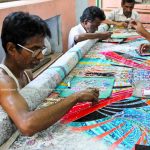Kanghi aur Lucknow
Nishita Banerjee combs the Kanghi Wali Gali to find the best hair care for herself
Comb making is yet another art that Lucknow is believed to have excelled in.
Once the city was a major centre for kanghi karigari. It is said that artisans from all over the country came here to learn the art.
It is always surprising to know how many different art forms had once existed in Lucknow. Talent and beauty had always gone hand in hand in every art form produced in the city.
Among the many unique professions and practices is the art of making kanghi, or comb. The exclusive Kanghi Wali Gali is a perfect example of the same which is in the Nakkhas area of the old city. It had once bustled with kanghi karigars but today just the name of the street remains and which resembles any other narrow, shabby street in the same area.
The karigars were skilled in making kanghis from the horn of different animals in the 18th and 19th centuries and the street was named after the kanghi makers residing in the area. It is believed that there were more than 100 karigars residing in the gali once, who had made the most magnificent combs.
Seventy year old Mohammed Usman is the very last kanghi karigar of the gali today. He inherited the art from his family and has been practising it for over 60 years. He talked of the intricacies of this art form.
To earn a living he puts up a small stall every year at the Lucknow Mahotsav, and it is the only time of the year when he earns a bit more than during the rest of the year. It disheartens him that there is none to take this profession forward after him.
The art of making kanghi from animal horn involves much skill and detailed steps. After the horn is found bought it is washed and dried. It is then continuously beaten into the required shape followed by cutting marks on the comb for the teeth. It is then sharpened with a tool similar to a file.
A lot of physical labour and hard work goes into making a kanghi but in the end it is sold cheap. Those that are designer combs fetch a little more money. After the introduction of cheap plastic combs in the mid 20th century, the horn made kanghis were no longer wanted and artisans too were forgotten.
Due to a lack of patronage, government indifference and intervention, kanghi makers have suffered and moved to other professions.

Kanghi Wali Gali




